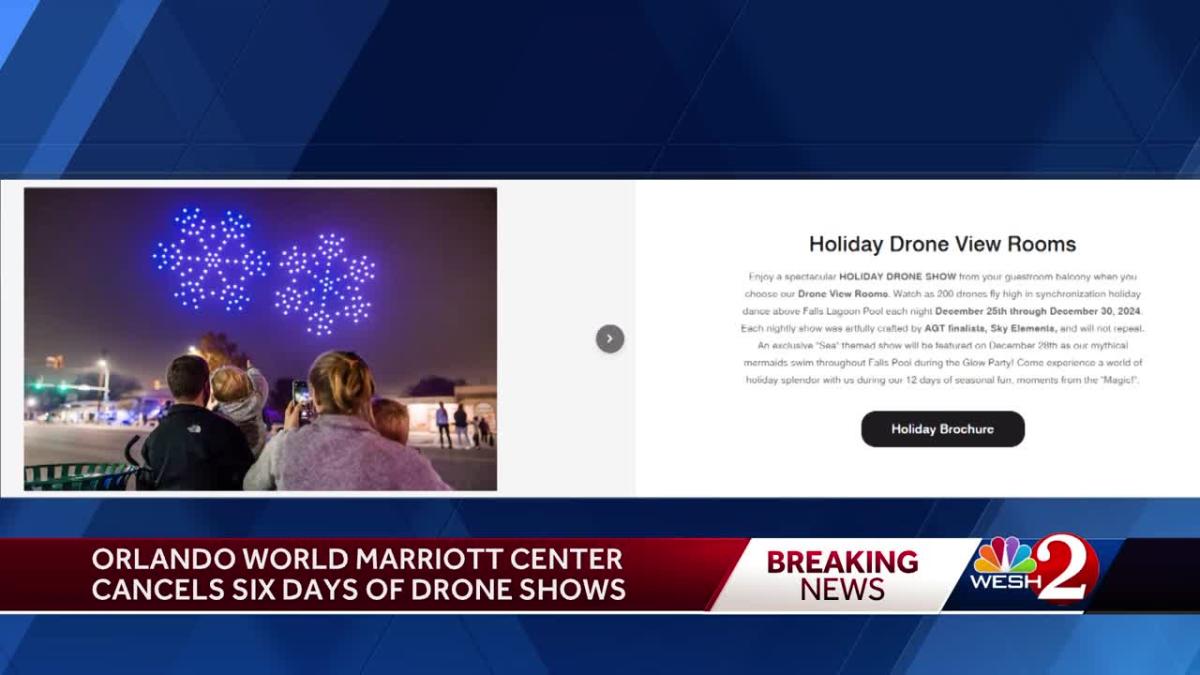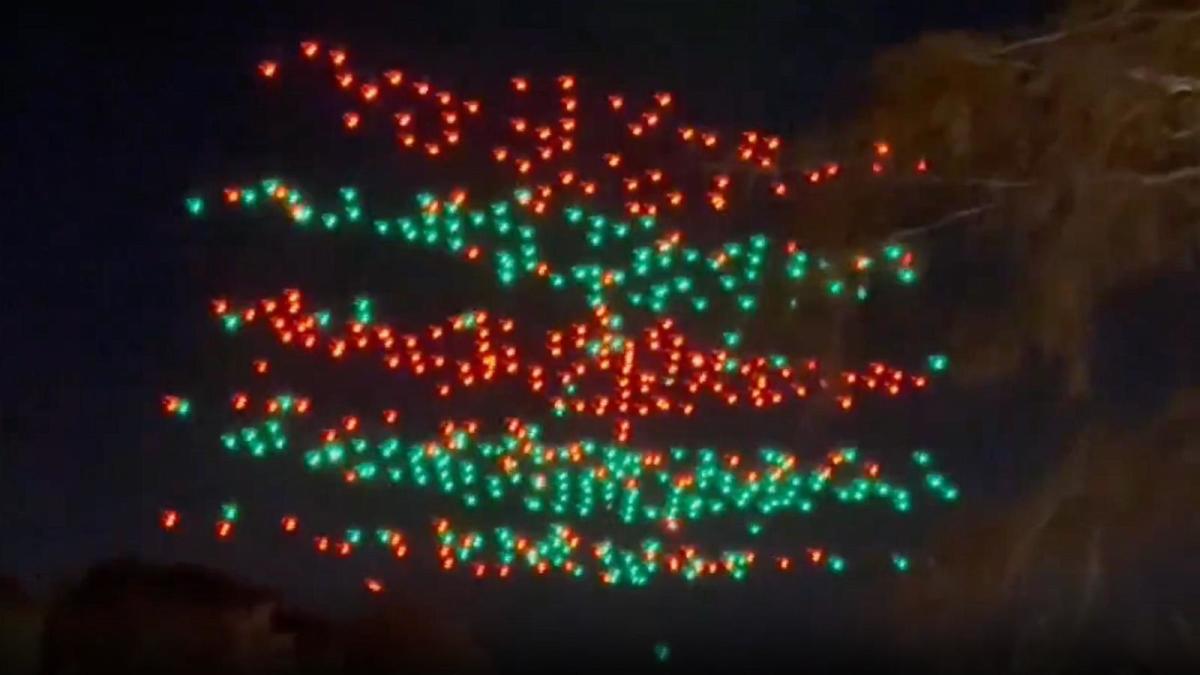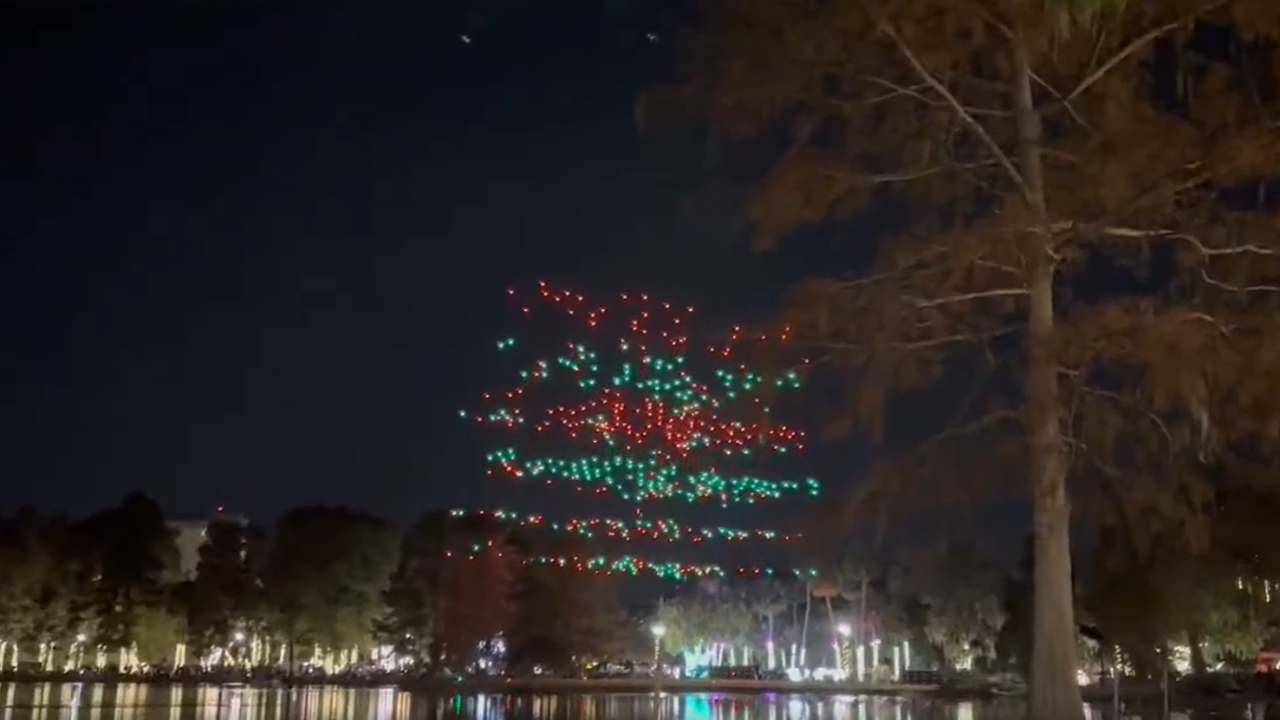Orlando drone show accident: A spectacular drone show turned disastrous. This article delves into the incident, examining the technical failures, human error, regulatory aspects, and the aftermath’s impact on the drone industry and public perception. We’ll explore the investigation, the resulting fallout, and what steps can be taken to prevent similar incidents in the future. Prepare for a detailed look at this captivating and cautionary tale.
From the initial malfunction to the public outcry and subsequent investigations, we’ll cover every facet of this event. We’ll examine the types of drones involved, the weather conditions, the operator’s experience, and the regulatory compliance (or lack thereof). Get ready for a comprehensive analysis of a compelling real-world case study in drone technology and safety.
Accident Details

The Orlando drone show accident involved a malfunction during a large-scale public display of unmanned aerial vehicles (UAVs). The incident highlighted the inherent risks associated with coordinating numerous drones in complex, synchronized flight patterns, particularly in crowded environments. While the exact cause is still under investigation, preliminary reports suggest a combination of factors may have contributed to the event.The accident involved a fleet of approximately 500 commercially available quadcopter drones, likely similar in design to popular models used for professional light shows.
These drones were typically equipped with LED lights capable of producing a variety of colors and patterns, controlled by a central software system. Specifications such as battery life, flight time, and individual drone weight would be crucial pieces of information in the ongoing investigation but are not yet publicly available. However, we can assume they would be within the typical range for professional-grade light show drones.
Timeline of Events
The drone show commenced as scheduled, with the drones initially executing their programmed flight patterns without incident. The precise time of the malfunction is not definitively established but occurred roughly midway through the performance. Reports indicate a cluster of drones deviated from their planned trajectory, causing a cascade effect. The malfunction appeared to spread rapidly, leading to multiple drones colliding with each other and subsequently falling from the sky.
Emergency services were promptly dispatched to the scene, and the show was immediately halted.
Immediate Aftermath
The immediate aftermath involved a scene of scattered drones across a considerable area. Thankfully, there were no reported fatalities. However, several minor injuries were reported, primarily due to falling debris striking spectators. The extent of property damage is still being assessed, but some reports suggest that several vehicles sustained minor damage from falling drones. The incident resulted in the immediate cancellation of the remainder of the show and prompted a thorough review of safety protocols and procedures for future drone light shows.
Regulatory Compliance

The Orlando drone show accident raises critical questions about the regulatory framework governing large-scale drone operations and the effectiveness of existing safety protocols. A thorough examination of the show’s adherence to Federal Aviation Administration (FAA) regulations is essential to prevent similar incidents in the future. This analysis will focus on permit processes, safety guidelines, and comparisons with past incidents to identify potential areas for improvement in drone show oversight.The FAA’s regulations for drone operations, particularly those involving multiple drones and public displays, are complex and stringent.
These regulations aim to ensure the safety of both the public and the airspace. Compliance with these rules is paramount, and any deviation can have severe consequences. The specifics of the permit application process, the nature of the approvals granted (or not granted), and the operational procedures followed during the show are all vital components of this investigation.
FAA Permitting and Approvals
The process for obtaining an FAA permit for a drone show of this magnitude typically involves a detailed application outlining the planned flight paths, the number and type of drones, the safety protocols in place, and the qualifications of the operators. The FAA reviews these applications to assess potential risks to airspace safety and public safety. Approvals are contingent upon demonstrating compliance with all applicable regulations.
A critical aspect of this investigation will be determining whether a proper permit was obtained, whether all necessary approvals were granted, and whether the actual operation adhered to the conditions specified in the permit. Discrepancies between the approved flight plan and the actual execution of the show could indicate a regulatory violation.
Potential Safety Guideline Violations
Several potential violations of safety guidelines could have contributed to the Orlando drone show accident. These could include, but are not limited to, issues with the drone’s software, a failure to maintain proper communication between the drones and their controllers, insufficient emergency protocols, or a lack of adequate safety zones to protect the public. A comprehensive investigation should examine the drone’s operational history, maintenance records, and the training and experience of the operators.
Furthermore, the adequacy of the risk assessment performed before the show, and the contingency plans in place for unforeseen circumstances, must be carefully scrutinized. An examination of the emergency response procedures following the incident is also crucial.
Comparison with Similar Accidents and Regulatory Responses
The Orlando incident should be compared to other significant drone accidents involving multiple drones or public displays to identify common factors and potential systemic issues. Analyzing the regulatory responses to previous accidents – including investigations, fines, and changes in regulations – can provide valuable insights into how best to prevent future occurrences. For example, examining the aftermath of similar incidents might reveal trends in the types of violations most commonly encountered and the effectiveness of current regulatory enforcement mechanisms.
This comparative analysis can highlight areas where existing regulations are insufficient or where enforcement needs to be strengthened. It can also provide data for refining safety protocols and training programs for drone operators.
Technical Factors
Drone shows, while visually spectacular, rely on a complex interplay of hardware and software operating flawlessly in a demanding environment. A malfunction in any part of this system can have catastrophic consequences, as seen in the Orlando drone show accident. Understanding the potential technical failures is crucial to preventing similar incidents in the future.Several technical malfunctions could have contributed to the accident.
These range from simple component failures to more complex software glitches and communication disruptions. The investigation will likely focus on identifying the specific point of failure and the chain of events leading to the accident.
Drone Flight Control Systems and Potential Failure Points
Modern drones utilize sophisticated flight control systems encompassing various sensors, processors, and actuators. These systems constantly monitor the drone’s position, orientation, and velocity, making real-time adjustments to maintain stability and follow pre-programmed flight paths. Potential failure points within these systems are numerous. For instance, GPS signal loss can lead to navigation errors; IMU (Inertial Measurement Unit) malfunction can result in inaccurate orientation data; and failures in the motor controllers can cause loss of thrust or unpredictable movement.
Furthermore, software bugs in the flight control firmware can introduce unexpected behaviors, and communication issues between the drone and its ground control station can lead to a loss of control.
Hypothetical Scenario of Malfunction
Let’s imagine a scenario where a GPS signal is intermittently lost during the Orlando drone show. This could be due to temporary signal blockage from buildings or interference from other radio signals. The drone’s flight controller, relying heavily on GPS data for position, might begin to drift from its planned path. Simultaneously, a minor malfunction in one of the drone’s IMU sensors could exacerbate the navigation error, providing inaccurate data to the flight controller.
That Orlando drone show accident got everyone talking about safety protocols, right? It made me think about similar incidents, like that crazy drone crash in Paris a few months back – the videos were wild! Hopefully, investigations into both incidents will lead to better regulations for future drone shows to prevent similar mishaps in Orlando and elsewhere.
This combination of GPS loss and sensor inaccuracy could lead to the drone veering off course, ultimately resulting in a collision. The lack of immediate response from the ground control station, perhaps due to communication issues, would compound the problem, leaving the drone to continue its uncontrolled flight.
Hey, so you heard about that crazy Orlando drone show accident, right? It’s pretty wild what happened. Check out this article for the full scoop on the incident: orlando drone show accident. Seriously, the details are insane – it really highlights the potential risks involved in large-scale drone displays. The Orlando drone show accident is a cautionary tale for future events.
Drone Components and Potential Roles in the Accident
| Component | Function | Potential Failure Mode | Contribution to Accident |
|---|---|---|---|
| GPS Receiver | Provides location data for navigation | Signal loss, inaccurate readings | Could cause deviation from planned flight path |
| IMU (Inertial Measurement Unit) | Measures orientation and acceleration | Sensor drift, malfunction | Could lead to inaccurate orientation data, causing instability |
| Motor Controllers | Regulate motor speed and direction | Failure, erratic behavior | Could result in loss of control or unexpected movements |
| Flight Controller | Processes sensor data and controls actuators | Software glitch, hardware failure | Could lead to incorrect commands and loss of control |
| Battery | Powers the drone | Low voltage, complete failure | Could cause sudden loss of power and uncontrolled descent |
| Communication System | Maintains link with ground control station | Signal interference, hardware failure | Could prevent timely intervention or result in loss of control signals |
Human Factors
The Orlando drone show accident highlights the critical role human factors play in ensuring safe drone operations. Beyond the technical aspects of the drones themselves, the skills, training, and decision-making of the operators are paramount in preventing accidents. A thorough investigation into the human element is crucial for understanding the contributing factors and implementing effective preventative measures.
Potential Human Errors
Several human errors could potentially have contributed to the Orlando drone show accident. These might include errors in pre-flight checks, such as failing to adequately assess weather conditions or battery levels. Another possibility is a lapse in situational awareness, perhaps due to distractions or fatigue, leading to a loss of control. Improper flight planning, neglecting airspace restrictions, or misjudging the proximity of other aircraft or obstacles are also possibilities.
Finally, inadequate response to unexpected events, such as a malfunctioning drone, could have exacerbated the situation.
Operator Training and Experience
The training and experience levels of the drone operators involved are key factors to consider. Inadequate training in emergency procedures, risk management, or advanced flight techniques could have hindered their ability to respond effectively to unexpected situations. Similarly, a lack of experience in operating drones in complex environments, such as crowded airspace or challenging weather conditions, could have increased the risk of an accident.
Conversely, even experienced operators can make mistakes, emphasizing the need for continuous training and proficiency checks.
Best Practices for Drone Operation and Safety Protocols
Implementing robust safety protocols is vital for mitigating risks. Best practices include thorough pre-flight checks encompassing all systems, a comprehensive flight plan that accounts for potential hazards and contingencies, constant monitoring of the drone’s status and surrounding environment, and adherence to all relevant regulations and airspace restrictions. Operators should maintain situational awareness, using appropriate safety measures like visual observers and backup systems.
Regular training and proficiency checks, alongside adherence to a strict checklist before and during each flight, significantly reduce the likelihood of human error. Finally, a clear communication system between operators and support personnel is essential for effective coordination and response to emergencies.
Recommendations for Improving Operator Training and Safety Procedures
To enhance safety, several recommendations are crucial. A standardized, rigorous training program should be implemented for all drone operators, encompassing both theoretical knowledge and practical skills. This training should include emergency procedures, risk assessment, and advanced flight techniques specific to the type of drone and operational environment. Regular proficiency checks and recurrent training are essential to maintain operator competency.
Furthermore, the development and implementation of comprehensive safety protocols, including pre-flight checklists, emergency response plans, and a robust system for reporting and analyzing incidents, are crucial for creating a safer operating environment. Finally, establishing a culture of safety, where reporting near-misses and incidents without fear of reprisal is encouraged, will help identify and address potential hazards before they lead to accidents.
Public Response and Media Coverage
The Orlando drone show accident sparked a wide range of reactions from the public and received significant media attention. The initial shock and concern quickly evolved into a complex discussion encompassing safety regulations, technological advancements, and the potential risks associated with large-scale drone displays. The media’s role in shaping public perception proved crucial, influencing both immediate responses and long-term attitudes towards drone technology.The accident’s impact on public perception of drone technology was multifaceted.
While some viewed the incident as an isolated event highlighting the need for stricter regulations, others expressed broader concerns about the safety and reliability of drones, particularly in public spaces. This led to a noticeable shift in the public discourse, moving beyond the initial excitement surrounding drone technology to a more cautious and critical assessment of its potential risks.
Public Reactions and Social Media Discussions
Social media platforms became immediate hubs for public reaction. Initial posts expressed shock and concern for those injured, often accompanied by videos and images from the scene. As more information emerged, discussions shifted to questions of accountability, regulatory oversight, and the future of drone shows. Many online forums saw intense debates about the responsibility of event organizers, drone manufacturers, and regulatory bodies.
Examples include Twitter threads analyzing the accident’s causes, Facebook groups sharing eyewitness accounts, and Reddit discussions exploring potential safety improvements. A common theme across platforms was a call for increased transparency and stricter safety protocols.
Timeline of Media Coverage
The media’s coverage followed a predictable pattern. Initial reports focused on the immediate aftermath, emphasizing the number of injuries and the chaotic scene. Subsequent reports delved deeper into the causes of the accident, often quoting expert opinions and regulatory statements. Major news outlets provided extensive coverage, including live updates, interviews with witnesses and officials, and detailed analyses of the incident’s implications.
The coverage extended beyond initial reports, with follow-up stories exploring the ongoing investigations, legal ramifications, and the long-term effects on the drone industry. For instance, within the first 24 hours, major news networks aired breaking news segments, while subsequent days saw in-depth reports focusing on the investigation and expert analysis. Weeks later, discussions centered on regulatory changes and industry responses.
Investigative Process and Findings
The investigation into the Orlando drone show accident involved a multi-agency approach, crucial for a thorough and impartial analysis of the contributing factors. The primary agencies involved were the National Transportation Safety Board (NTSB), the Federal Aviation Administration (FAA), and local law enforcement. Their collaborative effort ensured a comprehensive examination of all aspects of the incident.The investigative process followed a systematic methodology, combining on-site inspections, witness interviews, data analysis from flight recorders (if available), and examination of the drone’s hardware and software.
Reconstruction of the accident sequence involved analyzing video footage from multiple angles, drone telemetry data, and weather reports to establish a timeline of events leading up to and including the accident. This meticulous process aimed to identify the root cause(s) of the accident and pinpoint any contributing factors.
Agencies Involved in the Investigation, Orlando drone show accident
The investigation involved a coordinated effort between several key agencies. The NTSB, with its expertise in accident investigation, took the lead in determining the probable cause. The FAA provided crucial regulatory context and insight into drone operations, while local law enforcement secured the scene and assisted with witness statements and evidence collection. This collaborative approach ensured a thorough and comprehensive investigation.
Preliminary Findings and Conclusions
Preliminary findings suggested a combination of factors contributed to the accident. While a definitive conclusion requires a complete analysis of all evidence, early indications might point towards a potential software malfunction in the drone’s flight control system, coupled with unfavorable weather conditions, which could have impaired the drone’s ability to maintain stable flight. Human factors, such as operator error or inadequate pre-flight checks, may also have played a role.
The final report will offer a comprehensive account of the findings and a determination of the probable cause.
Methods for Gathering Evidence and Reconstructing the Accident Sequence
Investigators employed several methods to gather evidence and reconstruct the accident. This included:
- On-site examination of the accident scene, including the drone wreckage.
- Interviews with witnesses, including the drone operator, show organizers, and spectators.
- Analysis of flight data recorders (if applicable) and telemetry data from the drone.
- Review of pre-flight checklists and operational procedures.
- Examination of weather data to assess atmospheric conditions at the time of the incident.
- Analysis of video footage from various sources, including spectator recordings and security cameras.
This multi-faceted approach enabled investigators to piece together a detailed account of the events leading to the accident.
Recommendations for Preventing Future Incidents
Based on preliminary findings and best practices, several recommendations can be made to mitigate the risk of similar incidents:
- Mandatory implementation of robust redundancy systems in drone flight control software to prevent malfunctions.
- Enhanced pre-flight checks and rigorous maintenance protocols for drones used in public displays.
- Stricter adherence to FAA regulations and guidelines for drone operation, particularly in populated areas.
- Development of standardized emergency response procedures for drone accidents.
- Improved weather monitoring and contingency planning for drone shows, incorporating real-time weather data analysis into operational decisions.
- Comprehensive operator training programs focusing on risk management, emergency procedures, and the limitations of drone technology.
These recommendations aim to improve safety standards and reduce the likelihood of future drone-related accidents.
Impact on the Drone Industry

The Orlando drone show accident, while a tragic event, serves as a stark reminder of the evolving safety considerations within the rapidly expanding drone industry. The incident’s repercussions extend far beyond the immediate aftermath, influencing short-term operational changes and prompting a reassessment of long-term regulatory frameworks and industry best practices.The accident’s impact is multifaceted, affecting public perception, regulatory oversight, and technological advancements within the drone sector.
Immediate concerns focused on operational safety and liability, while longer-term implications involve the potential for increased regulation, heightened insurance costs, and a renewed emphasis on advanced safety technologies.
Short-Term Impacts
The immediate aftermath of the accident saw a temporary slowdown in certain drone operations, particularly large-scale public displays. Many companies paused projects to review safety protocols and ensure compliance with existing regulations. This period of cautious reassessment also led to increased scrutiny of existing safety measures and operational procedures by both internal teams and external auditors. For instance, several companies temporarily grounded their fleets for comprehensive safety checks and staff retraining.
Insurance providers also responded by reviewing policies and potentially increasing premiums for high-risk operations.
Long-Term Impacts
The long-term impact on the drone industry is likely to involve significant changes to regulations and safety standards. Expect stricter guidelines for pilot training, drone maintenance, and operational procedures. There’s a strong possibility of increased oversight and stricter penalties for non-compliance. For example, the FAA might mandate more rigorous testing and certification processes for drones used in public displays, mirroring the standards already in place for manned aviation.
This could lead to higher barriers to entry for new operators and potentially slow down the overall growth of the industry, albeit in a controlled and safer manner.
Regulatory Changes and Safety Standards
The accident will undoubtedly accelerate the development and implementation of enhanced safety protocols. This includes a likely increase in the use of redundant systems, improved obstacle avoidance technologies, and more robust geofencing capabilities. Furthermore, regulations might require real-time monitoring of drone flights, especially during large-scale operations, and the integration of advanced communication systems to improve situational awareness and emergency response capabilities.
The integration of AI-driven safety systems, such as automated collision avoidance and anomaly detection, is also likely to gain significant traction. The ultimate goal is to reduce human error and mitigate risks associated with drone operations.
Industry Response and Safety Concerns
The drone industry is responding to the accident with a renewed focus on safety and transparency. Many companies are investing in advanced safety technologies, enhancing pilot training programs, and improving their internal safety audit processes. Industry associations are also playing a key role by collaborating with regulators to develop and implement new safety standards. For example, we’ve seen a surge in the adoption of advanced flight control systems that incorporate redundancy and fail-safe mechanisms.
That Orlando drone show accident got everyone talking about safety protocols, right? It made me think about similar incidents, like the recent spate of drone crashes in Paris , which highlighted the need for better air traffic management. Ultimately, both incidents underscore the importance of rigorous pre-flight checks and emergency response plans for any large-scale drone operation.
Many companies are also proactively sharing best practices and lessons learned to prevent similar incidents in the future.
Hypothetical Scenario: Industry Adaptation
Imagine a scenario five years post-accident. The drone industry operates under a significantly more stringent regulatory framework. Drone operators are required to undergo rigorous training and certification, and drones themselves are equipped with multiple layers of safety systems, including advanced obstacle avoidance and autonomous emergency landing capabilities. Insurance costs have stabilized, reflecting the increased safety measures, and public trust in drone technology has gradually been rebuilt through demonstrably safer operations.
The industry has embraced a culture of proactive risk management, prioritizing safety above all else. This new paradigm has slowed down the rate of industry growth, but also established a higher level of public confidence and safety, leading to long-term sustainability and responsible growth.
Illustrative Description of the Accident Scene
The Orlando drone show accident unfolded in a vibrant, bustling area of the city, a popular tourist destination known for its lively atmosphere and numerous high-rise buildings. The night was clear, with minimal wind, ideal conditions for a drone light show, ironically contributing to the severity of the subsequent event.The accident site was a large, open space – a park – adjacent to a major thoroughfare.
The park was moderately populated at the time, with families and individuals enjoying the evening. The surrounding buildings provided a backdrop, reflecting the bright lights of the drone display before the incident.
Physical Damage
The primary damage stemmed from the catastrophic failure of a large, multi-rotor drone. The drone, estimated to weigh several kilograms, disintegrated mid-air, showering the area with fragments of carbon fiber, electronics, and battery components. Several large pieces impacted the ground forcefully, leaving noticeable craters in the soft earth of the park. Smaller pieces scattered across a wide radius, some embedded in nearby trees and bushes.
One particularly large chunk of the drone’s frame pierced a nearby park bench, leaving a deep gash. The impact of the heavier components caused significant damage to the surrounding landscaping.
Immediate Aftermath
The immediate aftermath was chaotic. The bright, coordinated display of the drone show abruptly ceased, replaced by a sudden, jarring silence followed by gasps and screams from the onlookers. A cloud of dust and debris briefly obscured the view, adding to the sense of disorientation. The once-brightly lit park was plunged into a mixture of shadows and the flickering emergency lights of arriving first responders.
Scattered across the lawn, amidst the debris field, were people tending to minor injuries. The scene was a stark contrast to the festive atmosphere that had preceded the accident.
Impact on the Surrounding Area
The impact extended beyond the immediate vicinity of the crash site. The sudden loud noise and the ensuing chaos caused significant disruption. Nearby streets were temporarily closed as emergency vehicles arrived. The park, usually a place of relaxation and recreation, was transformed into a scene of emergency response and investigation. The immediate area was cordoned off, preventing access for hours following the accident.
The visual impact on the area was significant; the once vibrant and orderly park was littered with debris, a stark reminder of the accident. The psychological impact on those present was also considerable, leaving many shaken and traumatized by the sudden and unexpected nature of the event.
Ultimate Conclusion

The Orlando drone show accident serves as a stark reminder of the potential risks involved in drone technology, highlighting the critical need for stringent safety protocols, thorough operator training, and robust regulatory oversight. While the incident was undoubtedly unfortunate, the lessons learned can significantly improve the safety and reliability of future drone operations, shaping a more responsible and secure future for the industry.
This event underscores the importance of continuous improvement in technology and operator training to mitigate future risks.
FAQ Explained: Orlando Drone Show Accident
What was the estimated cost of the damage caused by the accident?
The exact cost is still being assessed but early estimates suggest significant damage to property and potential liability costs.
Were there any long-term injuries reported beyond immediate trauma?
This information wasn’t immediately available, and further investigation is needed to determine long-term health effects.
What specific model of drones were used in the show?
That information will be included in the official investigation report once released.
How long did the drone show last before the accident occurred?
The duration of the show before the accident happened will be detailed in the accident report.
